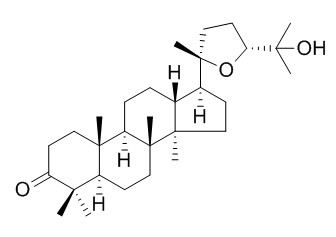Ocotillone
Ocotillone has potent antibacterial activity against Gram-negative bacteria, P. aeruginosa and S. typhimurium, that are without hemolytic activity, whereas it has weak antimicrobial activity against Gram-positive bacteria and fungi. Ocotillone shows only weak inhibitory activity against MCF-7 and NCI-H460 cells but moderate activity against A375-C5 cells.
Inquire / Order:
manager@chemfaces.com
Technical Inquiries:
service@chemfaces.com
Tel:
+86-27-84237783
Fax:
+86-27-84254680
Address:
1 Building, No. 83, CheCheng Rd., Wuhan Economic and Technological Development Zone, Wuhan, Hubei 430056, PRC
Providing storage is as stated on the product vial and the vial is kept tightly sealed, the product can be stored for up to
24 months(2-8C).
Wherever possible, you should prepare and use solutions on the same day. However, if you need to make up stock solutions in advance, we recommend that you store the solution as aliquots in tightly sealed vials at -20C. Generally, these will be useable for up to two weeks. Before use, and prior to opening the vial we recommend that you allow your product to equilibrate to room temperature for at least 1 hour.
Need more advice on solubility, usage and handling? Please email to: service@chemfaces.com
The packaging of the product may have turned upside down during transportation, resulting in the natural compounds adhering to the neck or cap of the vial. take the vial out of its packaging and gently shake to let the compounds fall to the bottom of the vial. for liquid products, centrifuge at 200-500 RPM to gather the liquid at the bottom of the vial. try to avoid loss or contamination during handling.
J of Essential Oil Research2019, 1677272
Front Microbiol.2022, 13:835463.
J Nat Prod.2019, 82(4):1002-1008
Horticulturae2024, 10(5), 486.
Biomed Chromatogr.2019, 8:e4774
Planta Med.2016, 82(13):1208-16
ACS Food Sci. Technol.2023, 3(2):273-282.
Int Immunopharmacol.2023, 125:111175.
Acta Biochim Pol.2015, 62(2):253-8
Anat Rec2018, 24264
Related and Featured Products
Z Naturforsch C. 2011 May-Jun;66(5-6):245-50.
Effect of triterpenoids and limonoids isolated from Cabralea canjerana and Carapa guianensis (Meliaceae) against Spodoptera frugiperda (J. E. Smith).[Pubmed:
21812341]
METHODS AND RESULTS:
The activities of two triterpenoids, Ocotillone and cabraleadiol, and four limonoids, methyl angolensate, 3-beta-deacetylfissinolide, 7-deacetoxy-7-oxogedunin, and beta-photogedunin, isolated from arillus of Carapa guianensis and fruits and seeds of Cabralea canjerana (Meliaceae), were evaluated against the fall armyworm Spodoptera frugiperda. Gedunin was used as a positive control.
CONCLUSIONS:
7-Deacetoxy-7-oxogedunin and beta-photogedunin reduced the pupal weight as occurred with gedunin. Cabraleadiol, 3-beta-deacetylfissinolide, and 7-deacetoxy-7-oxogedunin prolonged the larval phase similar to the control (gedunin) of approximately 1.2 days at 50.0 mg kg(-1). The highest insecticidal activity was obtained for beta-photogedunin.
J. Microbial. Biotechnol.,2002,12(5):854-7.
Antimicrobial effects of ocotillone isolated from stem bark of Ailanthus altisshima.[Reference:
WebLink]
METHODS AND RESULTS:
Bioassay-directed chromatographic fractionation of a methylene chloride extract of Ailanthus altisshima indicated the presence of 20(S), 24(R), epoxy-25-hydroxydammarane-3-one (compound 1, Ocotillone) which was isolated from this plant, for the first time. Antimicrobial activity of compound 1 was measured by inhibition of bacterial and fungal cells growth and by a hemolytic assay with human erythrocytes, respectively. The results revealed that compound 1 had potent antibacterial activity against Gram-negative bacteria, P. aeruginosa and S. typhimurium, that were without hemolytic activity, whereas it had weak antimicrobial activity against Gram-positive bacteria and fungi.
CONCLUSIONS:
These results demonstrated that the compound 1 has more antibacterial activity against Gram-negative bacteria, which have no hemolytic activity, than Gram-positive bacteria and fungi. This is the first report on the biological activities of the compound 1.
Chem Biodivers. 2006 Aug;3(8):930-4.
Two new tetracyclic triterpenes from the heartwood of Ailanthus excelsa Roxb.[Pubmed:
17193324]
METHODS AND RESULTS:
Two new dammarane-type triterpenes, ailexcelone and ailexcelol, together with Ocotillone, malabaricol, epoxymalabaricol, lupeol, and sitosterol-3-O-beta-D-glucoside were isolated from the heartwood of Ailanthus excelsa. The structures of the new compounds were established on the basis of 1D- and 2D-NMR data.
CONCLUSIONS:
Ocotillone, malabaricol and epoxymalabaricol were isolated for the first time from A. excelsa. All of the isolates were tested for their antifungal activity.



